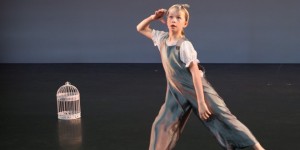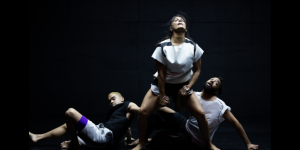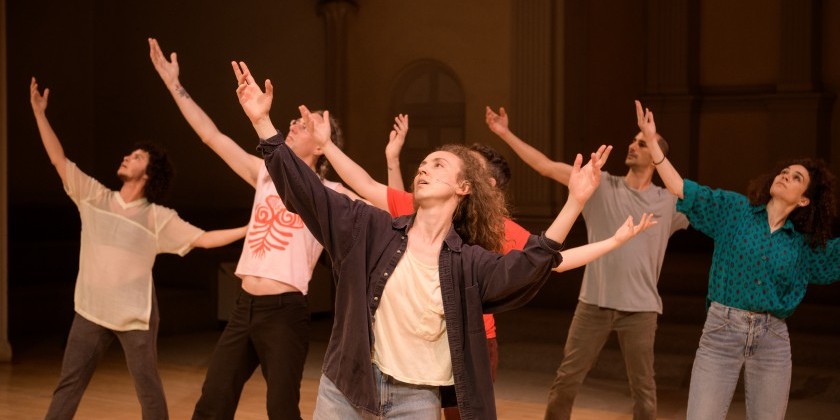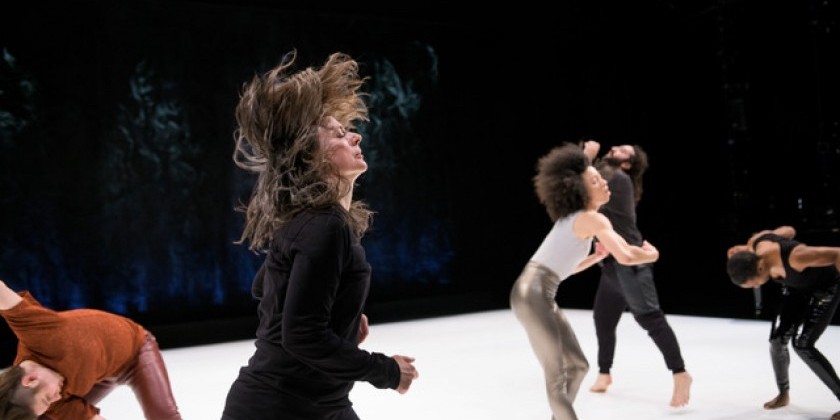Impressions of Ann Liv Young's "Elektra"

At New York Live Arts
Jan 20-23, 27-30 at 7:30pm
Created by Ann Liv Young
Performed by Lovey Ailish Guerrero, Marissa Mickelberg, Bailey Catherine Nolan,
Charley Parden, Vanessa Soudan, and Ann Liv Young
Artistic Collaboration by Annie Dorsen
Sound Design by Michael A Guerrero
Produced by Alexandra Rosenberg and Ann Liv Young Co.
Production Assistance by Tom Curitore and Christopher Willauer
Text of Elektra by Sophocles (Translated by Robert Bragg)
Much of the press about Ann Liv Young speaks of her occasional racist rants, use of porn and defecation on stage, and radical ban from MoMA PS1. It would come as no surprise then to walk into her premiere of Elektra in full mental and physical armor. Young’s Elektra is a loose re-telling of the Greek tragedy Electra, a tale of a woman who plots revenge against her mother and stepfather for the death of her father.
Act I begins with three women standing inside a sand-filled ring. Deep amber lights saturate the stage flattening their forms like paper doll cutouts. A miniature pig explores the boundaries of the ring, piercing the silence with oinks and squeals, while Marissa Mickelberg and Charley Parden silently stand along the periphery.
With ill-fitting costumes, interludes of bad karaoke, quick dance combinations, and poetic prose, Bailey Catherine Nolan, Vanessa Soudan, and Young exhibit a ferocious physicality and commitment to every moment. Young and Nolan have an all-out wrestling match. Nolan finds unconventional ways to perch upon a wooden chair until her extremities puncture the woven back and compromise the legs. Soudan partners with a bushel of branches for a flesh-smacking solo.
.jpg)
After intermission, the landscape is re-purposed in the image of a 1980s shimmery blue-jean tragedy wrapped in synthetic bubble gum. The cast reappears as new characters with the addition of Lovey Ailish Guerrero (Young’s 8-year old daughter) and Daniel Borg. Skating between softly sinister and mentally unstable, Elektra continues to unfold with in-your-face rap lyrics, raunchy dancing that infiltrates personal space, and action-based tableaus, which include an exhaustive pogo stick challenge and a masturbation scene.
Confused? It’s okay. The order of events feels intentionally random and haphazard.
Young offers performative transparency by stopping and starting the musical tracks at will. She provides the cast with audible ‘Go’ cues, and she demands mic checks without warning. She even instructs the tech staff to continuously restart a scene until the music reaches uncomfortable decibels. Granted, the irony of her lip-syncing to Eminem’s The Monster featuring Rihanna in this moment is not lost, but Young is not as reckless as some would lead you to believe. Her compassion for the performers and the special care she takes around Guerrero is evident. Soudan chauffeurs Guerrero backstage before the masturbation scene, and Young checks in with the cast between tableaus as needed. Their interactions feel sincere and exude genuine trust.

Young is clever. Her work provokes discussions about female appropriateness and the preciousness of the proscenium. Instead of being repulsed by Young’s work, one can see it as an opportunity to consider art-making and ownership. For instance, as Parden recites lyrics from a Kanye West song, generously tossing around the ‘n’ word, one must ask who are these lyrics for and who has a right to say them? This musical choice also illuminates the absence of people of color in Young’s work.
Young’s work begs the question: How is she able to take ideas to the extreme and verbally abuse audience and technical staff, yet continue to receive national and international support? Is it her privilege, or could it be her commitment to unapologetically disrupt theater expectations? Is it, perhaps, our magnetism toward a good train wreck? Who is the monster in this scenario? Young, presenters, critics, funders? Neither, several, all?
Whether or not you agree with her methods, Young’s Elektra continues to elevate her artistic voice as an intellectually provocative harpy with a force that is hard to ignore.
Share Your Audience Review. Your Words Are Valuable to Dance.
Are you going to see this show, or have you seen it? Share "your" review here on The Dance Enthusiast. Your words are valuable. They help artists, educate audiences, and support the dance field in general. There is no need to be a professional critic. Just click through to our Audience Review Section and you will have the option to write free-form, or answer our helpful Enthusiast Review Questionnaire, or if you feel creative, even write a haiku review. So join the conversation.














